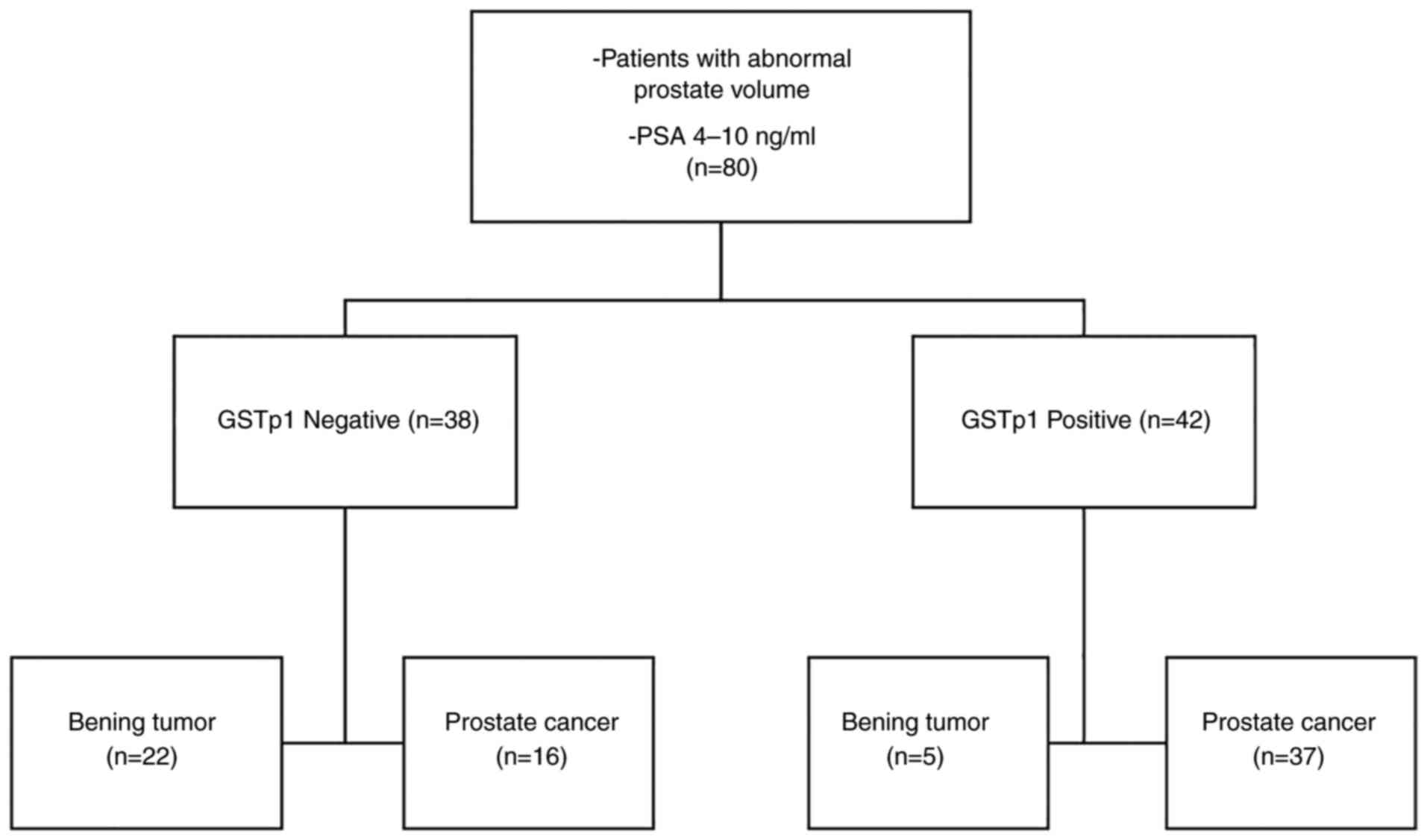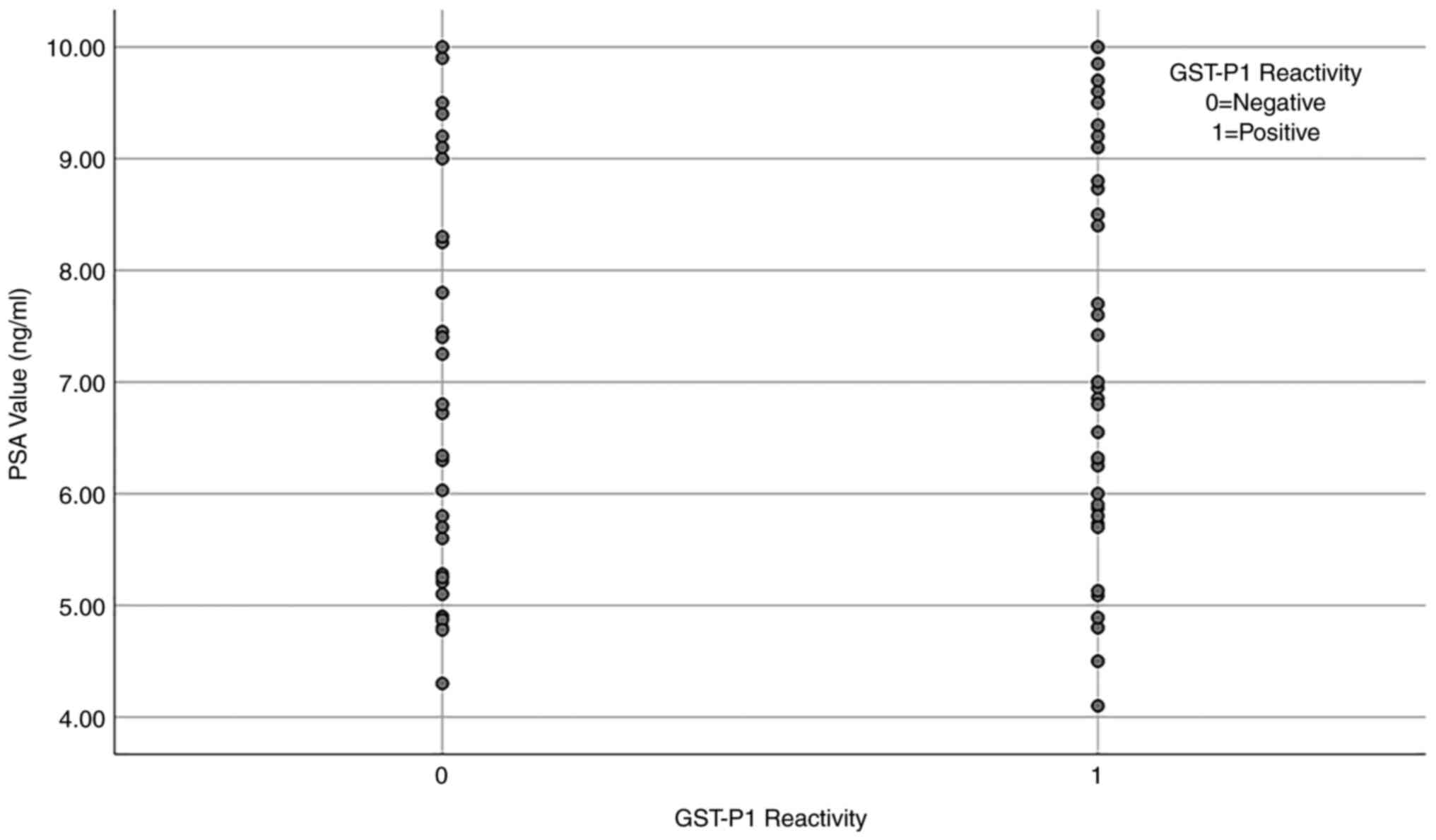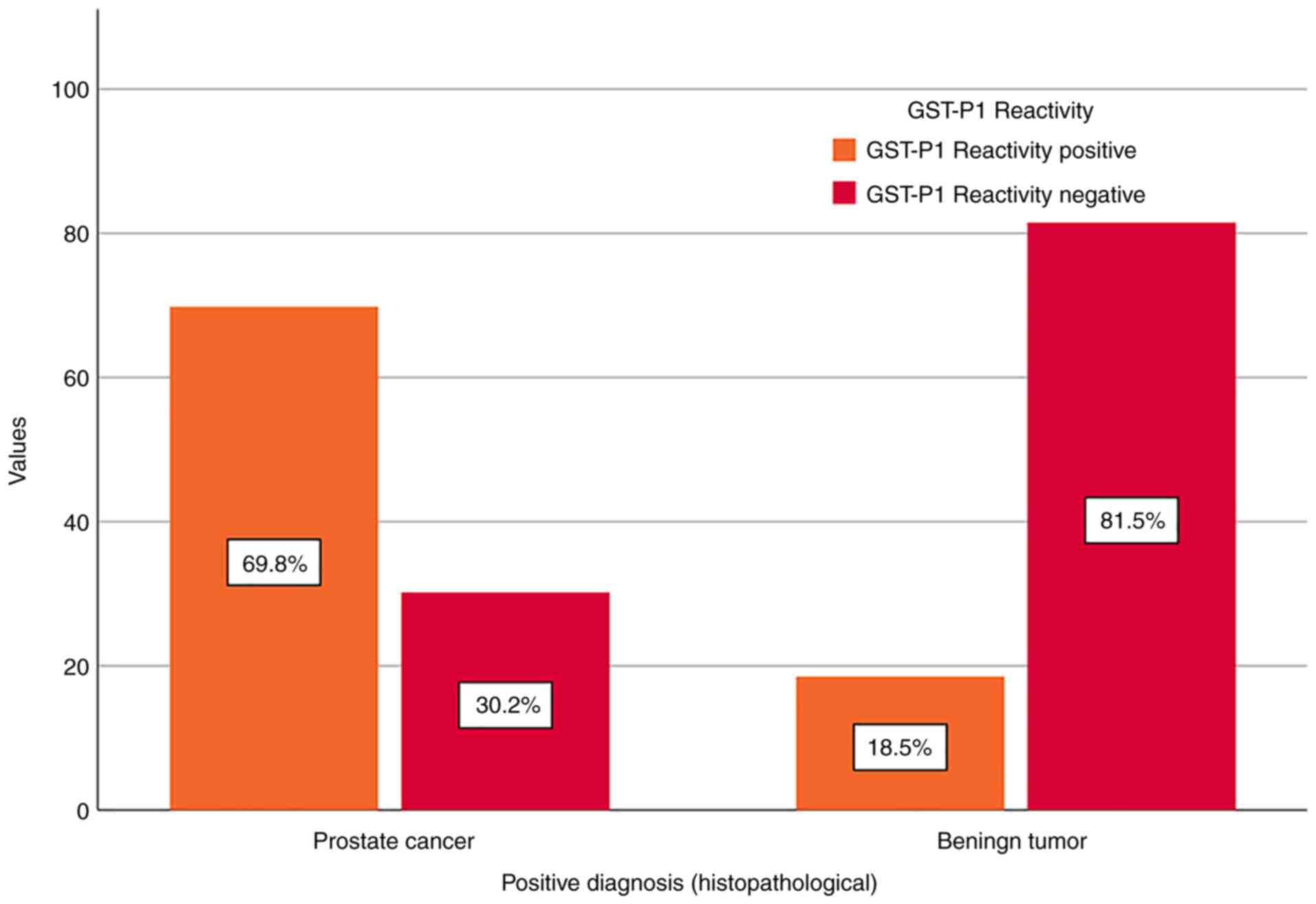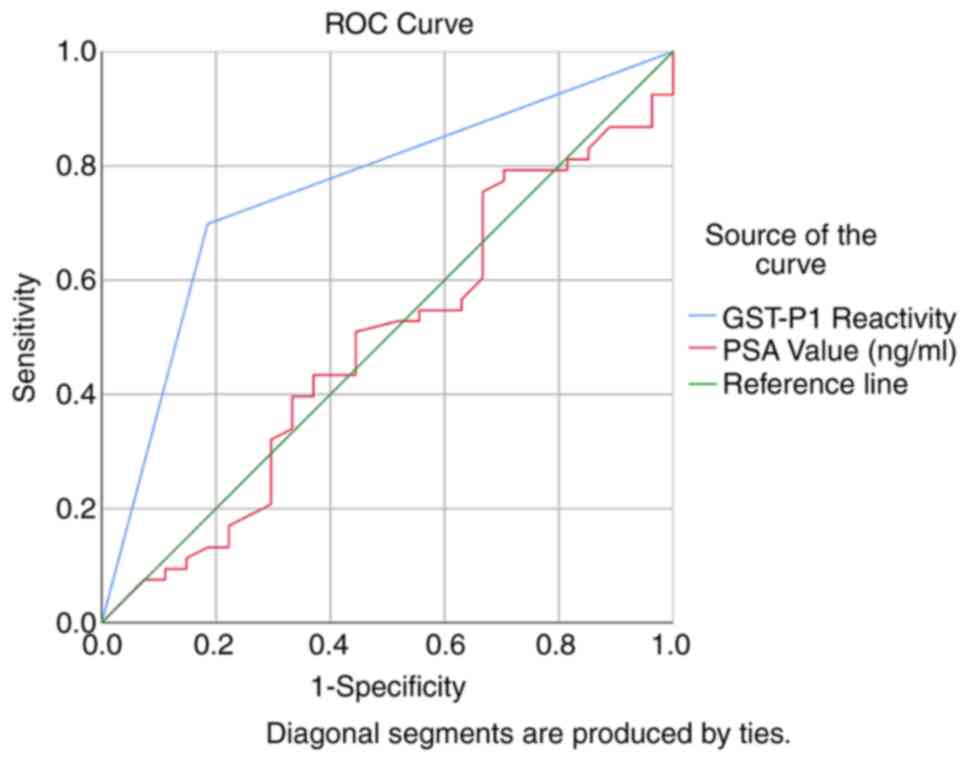|
1
|
Culp MB, Soerjomataram I, Efstathiou JA,
Bray F and Jemal A: Recent global patterns in prostate cancer
incidence and mortality rates. Eur Urol. 77:38–52. 2020.PubMed/NCBI View Article : Google Scholar
|
|
2
|
Iorga L, Dragos Marcu R, Cristina Diaconu
C, Maria Alexandra Stanescu A, Pantea Stoian A, Liviu Dorel
Mischianu D, Surcel M, Bungau S, Constantin T, Boda D, et al:
Penile carcinoma and HPV infection (review). Exp Ther Med.
20:91–96. 2020.PubMed/NCBI View Article : Google Scholar
|
|
3
|
Chirilă S, Rugină S and Broască V:
Neoplastic diseases incidence in constanta county during 2007-2012.
ARS Medica Tomitana. 20:211–214. 2015.
|
|
4
|
Ankerst DP and Thompson IM: Sensitivity
and specificity of prostate-specific antigen for prostate cancer
detection with high rates of biopsy verification. Arch Ital Urol
Androl. 78:125–129. 2006.PubMed/NCBI
|
|
5
|
Ashley T: Using predictive value,
sensitivity and specificity to interpret laboratory tests: PSA for
the diagnosis of prostate cancer. J Insur Med. 37:261–263.
2005.PubMed/NCBI
|
|
6
|
Ross T, Ahmed K, Raison N, Challacombe B
and Dasgupta P: Clarifying the PSA grey zone: The management of
patients with a borderline PSA. Int J Clin Pract. 70:950–959.
2016.PubMed/NCBI View Article : Google Scholar
|
|
7
|
Mottet N, van den Bergh RCN, Briers E, Van
den Broeck T, Cumberbatch MG, De Santis M, Fanti S, Fossati N,
Gandaglia G, Gillessen S, et al: EAU-EANM-ESTRO-ESUR-SIOG
guidelines on prostate cancer-2020 update. Part 1: Screening,
diagnosis, and local treatment with curative intent. Eur Urol.
79:243–262. 2021.PubMed/NCBI View Article : Google Scholar
|
|
8
|
Brooks D, Olver IN and Esterman AJ: Beyond
PSA testing for prostate cancer. Med J Aust. 208:426–427.
2018.PubMed/NCBI View Article : Google Scholar
|
|
9
|
Moyer AM, Salavaggione OE, Wu TY, Moon I,
Eckloff BW, Hildebrandt MA, Schaid DJ, Wieben ED and Weinshilboum
RM: Glutathione s-transferase p1: Gene sequence variation and
functional genomic studies. Cancer Res. 68:4791–801.
2008.PubMed/NCBI View Article : Google Scholar
|
|
10
|
Kornbrot D: Point biserial correlation.
In: Encyclopedia of Statistics in Behavioral Science. Everitt BS
and Howell DC (eds). John Wiley & Sons, Ltd., Hoboken NJ,
2005.
|
|
11
|
Henrique R and Jerónimo C: Molecular
detection of prostate cancer: A role for GSTP1 hypermethylation.
Eur Urol. 46:660–669. 2004.PubMed/NCBI View Article : Google Scholar
|
|
12
|
Santric V, Djokic M, Suvakov S,
Pljesa-Ercegovac M, Nikitovic M, Radic T, Acimovic M, Stankovic V,
Bumbasirevic U, Milojevic B, et al: GSTP1 rs1138272 polymorphism
affects prostate cancer risk. Med Lith. 56(128)2020.PubMed/NCBI View Article : Google Scholar
|
|
13
|
Bott SRJ, Williamson M and Kirby RS:
Chapter 11-Genetic changes and their prognostic significance in
prostate cancer. In: Prostate Cancer. Mydlo JH and Godec CJ (eds).
Academic Press, Oxford, pp101-112, 2003.
|
|
14
|
Zhou XL, Jiao DC, Dou MM, Chen JJ, Li ZN,
Li YH, Liu J and Han X: . Association of glutathione-S-transferase
p1 gene promoter methylation and the incidence of prostate cancer:
A systematic review and meta-analysis. J Cancer Res Clin Oncol.
145:1939–1948. 2019.PubMed/NCBI View Article : Google Scholar
|
|
15
|
Crocitto LE, Korns D, Kretzner L, Shevchuk
T, Blair SL, Wilson TG, Ramin SA, Kawachi MH, Smith SS, et al:
Prostate cancer molecular markers GSTP1 and hTERT in expressed
prostatic secretions as predictors of biopsy results. Urology.
64:821–825. 2004.PubMed/NCBI View Article : Google Scholar
|
|
16
|
Hoque MO, Topaloglu O, Begum S, Henrique
R, Rosenbaum E, Van Criekinge W, Westra WH and Sidransky D:
Quantitative methylation-specific polymerase chain reaction gene
patterns in urine sediment distinguish prostate cancer patients
from control subjects. J Clin Oncol. 23:6569–6575. 2005.PubMed/NCBI View Article : Google Scholar
|
|
17
|
Wu TY, Giovannucci E, Welge J, Mallick P,
LeMasters G, Tang WY and Ho S: Abstract 2797: Measurement of GST-P1
methylation in body fluids and prostate cancer diagnosis: A
meta-analysis. Cancer Res. 70 (Suppl 8):2797. 2011.PubMed/NCBI View Article : Google Scholar
|
|
18
|
Van Neste L, Herman JG, Otto G, Bigley JW,
Epstein JI and Van Criekinge W: The Epigenetic promise for prostate
cancer diagnosis. Prostate. 72:1248–1261. 2012.PubMed/NCBI View Article : Google Scholar
|
|
19
|
Cui J, Li GQ, Yin J, Li LW, Tan Y, Wei HR,
Liu B, Deng L, Tang J, Chen Y and Yi L: GSTP1 and cancer:
Expression, methylation, polymorphisms and signaling (review). Int
J Oncol. 56:867–878. 2020.PubMed/NCBI View Article : Google Scholar
|
|
20
|
Jerónimo C, Usadel H, Henrique R, Silva C,
Oliveira J, Lopes C and Sidransky D: Quantitative GSTP1
hypermethylation in bodily fluids of patients with prostate cancer.
Urology. 60:1131–1135. 2002.PubMed/NCBI View Article : Google Scholar
|
|
21
|
Cairns P, Esteller M, Herman JG,
Schoenberg M, Jeronimo C, Sanchez-Cespedes M, Chow NH, Grasso M, Wu
L, Westra WB and Sidransky D: Molecular detection of prostate
cancer in urine by GSTP1 hypermethylation. Clin Cancer Res.
7:2727–2730. 2001.PubMed/NCBI
|
|
22
|
Voinea F, Mazilu L, Micu IS, Suceveanu AP,
Iliescu M, Dumitru A, Constantin VD, Paunica I and Suceveanu AI:
Modern approaches for antiandrogen-resistant prostate cancer
therapy. J Mind Med Sci. 8(10)2021.
|
|
23
|
Woodson K, O'Reilly KJ, Hanson JC, Nelson
D, Walk EL and Tangrea JA: The usefulness of the detection of GSTP1
methylation in urine as a biomarker in the diagnosis of prostate
cancer. J Urol. 179:508–511. 2008.PubMed/NCBI View Article : Google Scholar
|


















